|
ITCH RELIEF

THE ITCHING PET: ALTERNATIVES TO STEROIDS
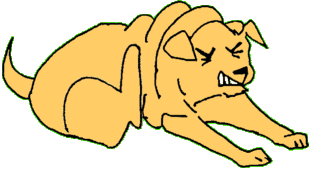
(original graphic by marvistavet.com)
Excessive licking, chewing, and scratching can make a pet’s life miserable for month after month, even year after year. No one likes to see their pet uncomfortable; further, the constant licking, chewing, and scratching can keep a pet owner up at night from the noise. Clearly, uncontrolled itching is a problem to solve before it gets out of hand.
For reliable rapid relief of itch and inflammation, nothing matches the corticosteroid hormones such as cortisone, hydrocortisone, triamcinolone, methoprednisolone, prednisone, dexamethasone, and others.) There are some animals that seem unable to live with any degree of comfort without these medications. Unfortunately, these hormones have widespread and potentially dangerous actions throughout the body when they are used for inappropriately long periods and it is generally desirable to minimize the use of these hormones when possible to do so. Ideally, corticosteroids are used for a few really tough itch weeks and other forms of itch management are used for “general itch maintenance.”
For more detail on long term corticosteroid use click here.
This is, of course, easier to write about than to actually do. When one's pet is scratching and chewing raw spots on his or her skin, practical advice is what is called for. The following list includes assorted non-steroidal methods for relieving itch and reducing the amount of corticosteroid hormones needed.
INFECTION CONTROL
|
When an animal becomes suddenly itchier, there is a tendency to assume there must have been a new or sudden allergen exposure. While this is possible, most of the time what has actually happened is an infection has taken root in the skin as a result of scratching and chewing. In many cases, controlling the infection will bring the pet back into its comfort zone and many allergic animals are managed by simply having their infections treated when they flare up.
The usual infections involve the Staphylococci bacteria and/or the Malassezia fungi that normally live on the skin surface. When the environment of the skin changes (allergic skin loses water and may have more oils), these organisms multiply and can gain access to deeper layers of the skin through abrasions caused by scratching and chewing. Soon there is a rash and/or an odor. Antibiotics generally handle these infections, though sometimes culture is necessary to determine what antibiotic is needed. Expect an itchy animal to have some skin samples reviewed under the microscope to check for infection. Some itchy pets need continuous management for these infections while, as mentioned, others only need periodic treatment. Ideally, in between infection flare ups additional treatments are used to extend the time between infection flare ups.
|
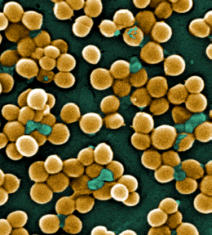
Staphylococcus bacteria
(Photo credit: CDC Public Health Image Library)
|
LONG ACTING INJECTABLES
LOKIVETMAB (CYTOPOINT®, "CANINE ATOPIC DERMATITIS IMMUNOTHERAPEUTIC," CADI)
A relatively new product is lokivetmab, a monoclonal antibody genetically engineered to target the canine version of a biochemical called "interleukin 31." Interleukin 31 is a type of cytokine and is an important mediator of itching so when it is inactivated by antibodies, relief from itch is rapidly achieved (usually beginning 8 hours after injection and readily apparent after 1 day). For over 80% of dogs receiving the lokivetmab injection, results are sustained for at least 4 weeks. That said, it does not work for every dog and while some dogs experience more than 4 weeks of relief, others experience less.
Lokivetmab does not effect pre-existing infections other than to make them not be itchy. It represents symptomatic relief only but for many itchy dogs, stopping the itch/scratch cycle is needed to curtail the vicious cycle and stop the perpetuation of skin infection. This is an excellent product to extend the interval between skin infection flare ups.
ORAL MEDICATIONS FOR LONG TERM ITCH CONTROL
CYCLOSPORINE (ATOPICA®)
Cylcosporine is an immuno-modulating drug originally developed for use in organ transplant patients but also useful in other immune-mediated diseases. Since allergy is an immune-mediated condition, cyclosporine was investigated as an alternative to corticosteroids and found effective for most patients. A good 4-8 weeks are needed to see a good response to cyclosporine which makes it fairly useless for acute flare ups. Typically it is combined with a medication that yields rapid itch relief so that by the time the itch is controlled, the cyclosporine can take over. Cyclosporine tastes bitter and commonly generates a mild upset stomach when it is first used but for most patients this is temporary and manageable. Cyclosporine is available for both dogs and cats.
For more information on Cyclosporine click here.
OCLACITINIB (APOQUEL®)
This relatively new medication represents a new approach to itch relief. It is called a JANUS- kinase inhibitor and it exerts its effects in the skin just as rapidly as do corticosteroids. This makes it helpful for both acute flare ups as well as long term management of itching. It is important to realize that its effects seem to be only on the sensation of itch and, unlike steroids, there is no anti-inflammatory result. This means that the patient’s itch can be controlled in the face of even advanced skin infection. This might sound like a good thing but there is concern that if the patient is not itching, the pet owner may not be motivated to perform the therapy needed to control the actual skin disease. Oclacitinib is approved for dogs but feline use is being explored. Patients should be over age one year and should not have a history of cancer or demodectic mange.
For more information on Oclacitinib click here.
|
|
FATTY ACID SUPPLEMENTATION (OMEGA THREE FATTY ACIDS)
The discovery of anti-inflammatory properties of evening primrose oils and fish oils in humans has led to similar products on the market for our pets. These products are not analogous to the oil supplements which are recommended as food supplements to make a pet's coat shiny; instead these are true anti-inflammatory medications capable of relieving joint pain, cramps, and itchy skin.
They are not at all useful for acute flare ups of itch as they require weeks to build up in the body in order to exert an effect. Instead, they are used for long term management in making the skin less able to generate inflammatory mediators. (Essentially, they make the skin less reactive to allergens).
The supplement alone is mild in its ability to prevent itch but it can be used to boost the effects of other anti-itch medications.
For more information on Fatty acid supplementation click here.
|
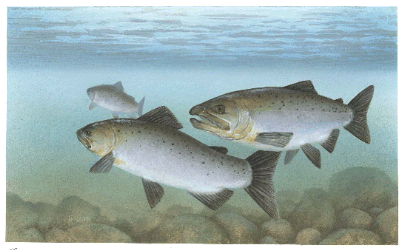 Pacific Salmon Pacific Salmon
(Photocredit: Public Domain Graphic via Wikimedia Commons) |
ULTRA-MICROSIZED PALMITOYLETHENOLAMIDE OR "PEA" (REDONYL®)
PEA is a natural substance made by both plants and animals. In animals, it is involved in restoring balance to the skin's biochemistry and preventing release of the biochemical mediators of itch. (The actual process involves enhancing levels of endogenous endocannabinoids and is fairly complex.) The commercial product uses an extract of soybeans to obtain its PEA and creates a super concentrate as it would not be possible to eat enough soybeans to garner a therapeutic dose of PEA. The super small "ultra micronizing" allows for better absorption of the product into the body. It is available as a flavored chew for dogs but can also be used in cats.
|
ANTIHISTAMINE TRIALS
Histamine, a biological chemical, is the chief mediator of inflammation in humans hence the proliferation of antihistamines available for people both by prescription and "over the counter." Histamine is not the major mediator of inflammation in the dog, thus these medications are not as reliable for dogs as they are for us.
The International Committee on Allergic Diseases in Animals puts out guidelines for the management of atopic dermatitis and they divide itch into acute flare ups and more chronic daily levels of itching. They found very little benefit from antihistamines for acute flare ups except for mild cases and consider that the drowsiness side effect may be responsible for any reduction in scratching. For more chronic cases, daily use of antihistamines fared better with the idea that regular use might be preventing flare ups even if antihistamines were not so good at actually treating flare ups. Responses were variable between individuals.
|
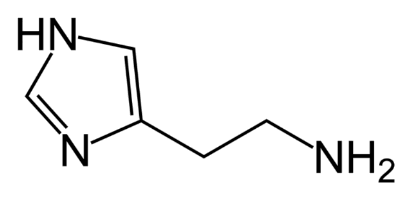 Chemical structure of Histamine. Chemical structure of Histamine.
(Photocredit: Public Domain Graphic via Wikimedia Commons) |
While the chance of any one antihistamine being effective is small (about 15% on the average), trying several antihistamines sequentially often leads to finding one that works. It is important to note that many antihistamines have a drowsiness side effect as well. Antihistamines commonly used for such trials include:
In the cat, antihistamines are substantially more reliable than in dogs so that the chances of a given antihistamine working are usually pretty good. For both cats and dogs, using antihistamines together with a corticosteroid hormone will decrease the amount of corticosteroid hormone needed to control the itching (i.e. less hormone is needed to get the job done if it is given with an antihistamine).
TOPICAL THERAPIES
TOPICAL STEROIDS? - It seems clear that taking steroids orally may be harmful to the body with chronic use but are topical cremes safe for long term use? We now know that topical steroids (cortisone crèmes, sprays, and related products) are absorbed through the skin and into the bloodstream, but the systemic hormonal side effects achieved with topical use do seem blunted and probably only of significance for very small dogs. This makes topical steroid use a much safer long term approach relative to oral or injectable steroids. Of course, the entire animal cannot be enrobed in topical steroid cremes but for small irritated areas (hot spots), topicals can provide excellent relief without the systemic effects of hormones. They are best used for acute flare ups.
|
SHAMPOO THERAPY
There are many benefits to shampoo therapy: luke warm water is inherently soothing, crusts and dandruff which could be inherently itchy can be removed, pollens and other allergenic substances can be washed away, the skin can be either moisturized or stripped of excess oil depending on what is needed and, of course, medications can be delivered in the shampoo lather itself. Skin can be moisturized with shampoo therapy which is reduces the sensitivity of the skin to itch stimulation. (The “itch threshold” is raised via skin hydration). As technology advances, new products are introduced and new ways to prolong their effects are developed. Here are some general choices that might be helpful:
|
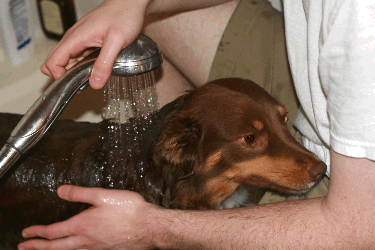 (Photocredit: Morguefile.com) (Photocredit: Morguefile.com) |
|
COLLOIDAL OATMEAL SHAMPOOS AND CREME RINSE - At first, these products were only available for human use, as powdered "soaks" to pour into bath water. Once their value in itch management was determined, their use quickly spread to the veterinary field. Colloidal oatmeal has an unknown method of action but generally yields 1-3 days of relief. The creme rinses are meant to yield longer acting relief. They are available plain or combined with local anesthetic formulas (usually pramoxine) to soothe itch.
|
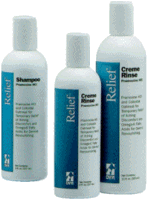
|
|
PHYTOSPHINGOSINE AND OPHYTRIUM CONTAINING PRODUCTS – These products contain phytosphingosine, a natural skin biochemical important in maintaining the skin’s natural barrier to infection and inflammatory substances or ophytrium, which is a monkey grass derivative . Phytosphingosine is moisturizing, anti-inflammatory (both directly and by fortifying the skin’s barrier function), and has antimicrobial properties (preventing and treating bacterial as well as yeast infections). Ophytrium similarly supports the natural skin barrier, which helps the skin defend against infection. Products are available in shampoos as well as sprays.
|
|
LIME SULFUR DIP - This product kills parasites, ringworm fungi, and bacteria. It also dries moist, weeping skin lesions and helps dissolve surface skin proteins that are involved in itchiness. Many veterinary dermatologists recommend it regularly to control itch; however, it has several disadvantages. IT SMELLS TERRIBLE. The sulfur ingredient smells like rotten eggs and this is how your bathroom or bathing area will smell during the pet's bath. This dip can stain jewelry and clothing and will temporarily turn white fur yellow.
OTHER SHAMPOOS
Itchy skin can be the result of skin infection, excess oil accumulation, yeast infection, even parasitic infection. The list goes on. The shampoo products listed above can be used against any itchy skin disease but it should be noted that there are many other shampoo and creme rinse products that can be used against the specific conditions.
AT LEAST TEN MINUTES OF SKIN CONTACT IS THE MINIMUM REQUIREMENT FOR ANY MEDICATED SHAMPOO.
PREMATURE RINSING WILL NOT ALLOW FOR THE THERAPEUTIC BENEFIT TO BE REALIZED.
RESPECT THE STEROID
Severe itching amounts to a reduction in life quality. It is important not to develop the mindset that corticosteroids should be avoided at all costs. This would not be fair to the itching pet. Steroids are valuable tools in the relief of pain and suffering and have an important place the therapy of the itchy pet. The goal is not to avoid steroid use if possible but to avoid long term dependence on steroids if possible. Despite all of the above management tricks, some pets will still require long term steroid use to achieve any reasonable comfort. There are monitoring protocols in place for such cases. It should also not be forgotten that underlying allergies and recurring skin infections can be addressed specifically and that as these conditions are managed, the itch is also managed.
Steroid hormones have many side effects and, as helpful as they are for allergic skin diseases, it is best to reserve them for only the most itchy episodes.
AND A FEW WORDS ABOUT FLEA CONTROL
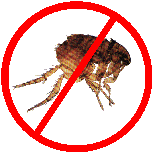 |
We receive email on a daily basis from people with itchy pets who are convinced that fleas are not involved in the problem. When we examine such pets, we find fleas actually are contributing to the itching in at least 50% of cases and the owner is invariably surprised to see the live fleas when they find them. Since any itchy skin disease is made worse by the presence of fleas, good flea control is imperative and it is important not to assume that not seeing fleas means they are not there. For example, if your pet’s itchiest areas include the lower back, this is a strong indicator that fleas are present whether you see them or not. Often becoming diligent with flea control is the least expensive and least labor-intensive way to control a pet’s itch symptoms
To view a chart comparing flea products so that you can pick one that is best for you click here.
|

Page last updated: 6/21/2021
|